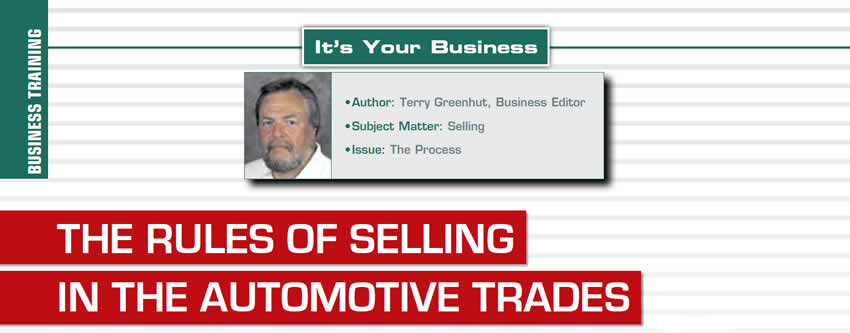
It’s Your Business
- Author: Terry Greenhut
- Subject Matter: Selling
- Issue: The Process
In last month’s segment I already mentioned the first rule of selling, which is: Nobody in their right mind wants to spend anything to have a car repaired. They will spend to buy something they want but an auto repair is just not one of those things. It is a necessary evil. It always was and it always will be. So your career as an owner or a service advisor will put you into fight mode every day. You need to be able to handle that type of stress by coming up with enough ways to win that make you feel fighting for your price is a worthwhile endeavor. If you get scared or lazy about it along the way you and the shop will lose money and put you into a downward slide that is difficult to recover from.
I know a lot of people in our business who, either due to lack of skill or training at selling, feel that the best way around the problem is to charge prices low enough that customers won’t argue them at all. But that’s what we call in selling, “Stinkin’ Thinkin’” because it doesn’t work. No matter what price point you start out at customers will always challenge it so if you start out by offering your rock bottom number, the one that barely keeps your doors open and the customer negotiates you lower, you’ve instantly lost any profit you might have made and that’s not what you’re there for.
You need profit dollars to keep the business alive and growing. They allow you to pay good wages and benefits so you can afford top-notch employees who will in turn do the best work for your customers. They pay for new and better equipment and expansion and, just as important, allow the shop owner to make a decent return on his or her investment, which I believe they deserve for sticking their necks out to open a business that provides employment and renders quality service to its customers.
Rule 2: Create a level of trust between you and the customer.
From the outset customers don’t trust us. Most don’t understand what we do or how we can magically make their cars run right again. The ones that do usually oversimplify the work in their minds or because one of us made it sound too simple and think we charge too much for it. Then there are those who think they were taken advantage of by some repair facility in the past or have heard stories from others who felt that way.
We, in this industry, are the biggest culprits though. We can and often do destroy trust by committing one of the two mortal sins that completely destroy trust and make selling far more difficult than it needs to be. The first sin is knocking other shops. I don’t care if you think you know that the guy down the street doesn’t do a good job. You don’t really know that. You take other people’s words for it, people who could be upset with that shop for any one of many reasons, legitimate or not. If you start knocking that or any other shop to your customers you are in essence knocking the entire industry, which, since you are a member of, is knocking yourself. I think Mama was right when she taught us, “If you can’t say something nice about someone you’re better off not saying anything at all.” When a customer mentions another shop to you or asks about them your best response might be, “I’ve heard of them. I don’t know exactly what they do there. I can only tell you what we do.” If that sounds non-committal, it should. It is not our place to judge what others do, only what we do.

The second sin is to quote prices over the phone on the customer’s initial call without ever having had the opportunity to check out the problem. More sales are lost owing to that reason than any other. You may think you are a top-notch diagnostician and maybe you are, but even you can be way off base with your diagnosis at times and basing that diagnosis on information supplied to you by a lay-car owner can put you completely in the wrong ballpark.
So let’s say that you have just condemned a transmission based on information the customer gave you, even if that information was, “I had it checked at another shop or I called around and other shops told me I needed a transmission and gave me a price to fix it.” Would it be right for you to quote a price? Only if you want to destroy any chance that this customer will ever trust you!
To build trust you would need to cast some level of doubt on whether they really do need a transmission or if something less invasive might solve their problem. Then invite them into your shop to check it out for free to see if there is any way you can save them some money. Understand that aside from the fact that they don’t want to spend money to get their cars fixed they really don’t want to spend any just to find out what’s wrong.
When you quote a sight unseen price over the phone you are agreeing with their diagnosis. It’s like saying, “You’re right and this is what it’s going to cost you.” I don’t know about you but that would raise an awful lot of red flags in my mind if I were the customer. To trust someone I would want to feel that he or she would work to get me the best price on the right repair or service and if I was told that in order to do that I would need to let them check out the problem, I would be inclined to do that. Trust is really important when you’re dealing with a “Black Box.”
Rule 3: Offer hope
Whenever anything goes wrong in people’s lives, until they know exactly what they are up against they want to hope that it isn’t going to be as bad as they first imagined. When you agree with them during initial contact that they have a major problem you take away that hope giving them much less of a reason to bring the car in now.
Your best bet is to use phrases that give them hope that if they pay you a visit it might save them money. Phrases like, “I wouldn’t want to see to you spend any more than you have to.” “I wouldn’t want to mislead you by trying to guess at your problem or the cost of repairs.” “It might not be as bad as you think.” “Come on in and let me see if I can save you some money.”
Rule 4: Price is the first thing a customer asks and the last thing a salesperson wants to discuss.
If you were looking to buy something that you didn’t know much or anything about it would be difficult, if not impossible, to know what the right questions were to ask a salesperson. There is one question though that applies to any product or service. How much does it cost? You shouldn’t be upset when a caller asks that as their first question. It may be the only one they know to ask. You can’t answer it though. If you try to you will statistically scare off 80% of your callers. Knowing that, any price you quote will not be the amount you really want or need for fear of losing them so you quote something lower trying to appeal to the 20% you have left and that group probably won’t let you make any money if they do show up. Quite a dilemma isn’t it? The answer is simple. Don’t quote prices over the phone on the initial call. But how? We’ll go into that in the section on how to properly deal with telephone contacts in a separate article.
What you need to know for now is that there is a series of steps that lead up to quoting a price that you must follow to be consistently successful at selling.
- 1: Get four wheels firmly planted in your driveway. You have nothing until you have that. People will promise to bring cars in but until they actually show up or let you tow them in you have nothing.
- 2: Meet and greet the customer. Try to get them to come in with the vehicle. That will be your chance to impress them with your shop and the way they will be treated.
- 3: Qualify the customer. There are several specific questions you can ask that will give you insight into how the customer will respond when you finally do quote the price.
- 4: Do a preliminary check of the vehicle. Check what you need to in order to determine if the vehicle needs a minor repair that can be done on the spot, or with an appointment, or if it needs to be left for further diagnostic testing.
- 5: Sell diagnostic time if necessary. If a problem looks like it will be one that requires a considerable amount of diagnostic time sell the first hour of it with the stipulation that you will call the customer if more time is required.
- 6: Separate the customer from the vehicle. Once you have determined that a certain repair or additional diagnosis needs to be done it is best for the customer to leave the vehicle with you and go somewhere else until you can contact them with more information. Customers hanging around, especially for long periods of time, create undue stress on you and your employees and can cost sales when other customers are present. Offer a ride home or to work. Get them into a rental or a loaner.
- 7: Price out the job. Write up a complete estimate or repair order. Remember that the more you write the more you get for the job. Customers want to see detail. One-liners like “Rebuilt Transmission” don’t get the job done. Break it down into parts and labor operations to show value. The more you write the less they fight.
- 8: Present your findings either in person or over the phone. You can ask if they want you to quote the price in parts and labor or as a whole. Either way you need to explain what they are getting for their money and the benefits of doing business with you.
As you can see there are many steps involved in the process. When you give a price on the initial phone call you are cutting out the entire sales process. It’s as if you are saying, “I don’t know anything about you or your vehicle, but since you asked me for a price here it is; take it or leave it.”
Hanging up on you means they are leaving it and any chance you might have had to sell anything goes away with it.
Next time we’ll look into more rules of selling to help you become a top-notch service advisor or to hone your skills if you already are one.















